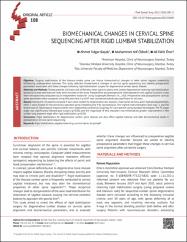| dc.contributor.author | Başak, Ahmet Tulgar | |
| dc.contributor.author | Özbek, Muhammet Arif | |
| dc.contributor.author | Özer, Ali Fahir | |
| dc.date.accessioned | 2022-10-13T12:29:39Z | |
| dc.date.available | 2022-10-13T12:29:39Z | |
| dc.date.issued | 2022 | en_US |
| dc.identifier.citation | Başak, A. T., Özbek, M. A. ve Özer, A. F. (2022). Biomechanical changes in cervical spine sequencing after rigid lumbar stabilization. Journal of Turkish Spinal Surgery, 33(3), 108-112. https://doi.org/10.4274/jtss.galenos.2022.91885 | en_US |
| dc.identifier.issn | 2147-5903 | |
| dc.identifier.uri | https://doi.org/10.4274/jtss.galenos.2022.91885 | |
| dc.identifier.uri | https://hdl.handle.net/20.500.12511/9837 | |
| dc.description.abstract | Objective: Surgical stabilization of the thoraco-lumbar spine can induce biomechanical changes in other spinal regions, potentially influencing postoperative outcome. This study detected biomechanical changes in cervical spine sequencing and identify preoperative parameters associated with these changes following rigid stabilization surgery for degenerative lumbar spinal disease. Materials and Methods: Twenty patients (10 males and 10 females, mean age 64.6 years) with lumbar degeneration receiving rigid stabilization (polyaxial screws and titanium rods) were included in the study. Preoperative and postoperative anterioposterior and sagittal scoliosis x-rays were retrospectively evaluated by an independent researcher using SurgimapR (Nemaris Inc., USA). Preoperative and postoperative cervical spine parameters were compared using Wilcoxon test. A p<0.05 was considered statistically significant for all tests. Results: Among the 20 patients enrolled, 4 each were treated for degenerative disc disease, 5 had spinal stenosis, and 3 had spondylolisthesis, while 5 were treated for the previously operated spinal instability and 3 for spondylolysis. The highest instrumentation level was L1 and the lowest was L5. Radiological measurements were obtained by calibrating Surgimap for each patient using standard techniques. The T1 slope angle was significantly reduced post-surgery (p<0.05), and the magnitude of this reduction was enhanced by greater improvement in the lumbar long segment angle after rigid stabilization (p<0.05). Conclusion: Rigid stabilization for degenerative lumbar spine disease can also affect sagittal balance and alter biomechanical loads in postoperative cervical spine sequencing. | en_US |
| dc.language.iso | eng | en_US |
| dc.publisher | Galenos Publishing House | en_US |
| dc.rights | info:eu-repo/semantics/openAccess | en_US |
| dc.subject | Rigid Stabilization | en_US |
| dc.subject | Sagittal Balancing | en_US |
| dc.subject | Cervical Spine | en_US |
| dc.subject | SurgimapR | en_US |
| dc.title | Biomechanical changes in cervical spine sequencing after rigid lumbar stabilization | en_US |
| dc.type | article | en_US |
| dc.relation.ispartof | Journal of Turkish Spinal Surgery | en_US |
| dc.department | İstanbul Medipol Üniversitesi, Tıp Fakültesi, Cerrahi Tıp Bilimleri Bölümü, Beyin ve Sinir Cerrahisi Ana Bilim Dalı | en_US |
| dc.authorid | 0000-0002-1847-2562 | en_US |
| dc.identifier.volume | 33 | en_US |
| dc.identifier.issue | 3 | en_US |
| dc.identifier.startpage | 108 | en_US |
| dc.identifier.endpage | 112 | en_US |
| dc.relation.publicationcategory | Makale - Uluslararası Hakemli Dergi - Kurum Öğretim Elemanı | en_US |
| dc.identifier.doi | 10.4274/jtss.galenos.2022.91885 | en_US |
| dc.institutionauthor | Özbek, Muhammet Arif | |
| dc.identifier.scopus | 2-s2.0-85160275534 | en_US |
| dc.identifier.trdizinid | 536068 | en_US |


















